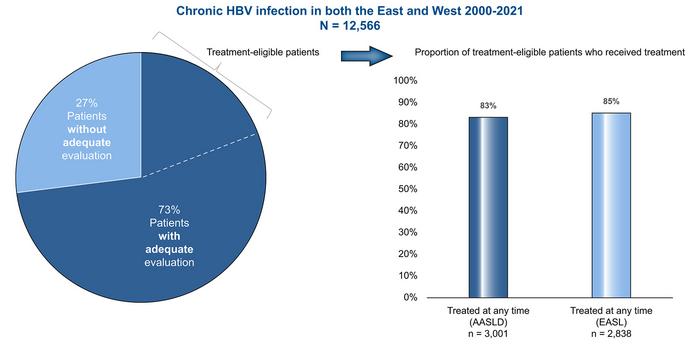Hepatitis B is globally underassessed and undertreated, especially among women and Asian minorities in the West
Amsterdam, May 2, 2024 – New evidence reveals global underassessment and undertreatment of chronic hepatitis B (HBV), especially among women and Asian minorities in the West, a new study in the Journal of Hepatology, published by Elsevier, details. Credit: Journal of Hepatology Amsterdam, May 2, 2024 – New evidence reveals global underassessment and undertreatment of […]

Amsterdam, May 2, 2024 – New evidence reveals global underassessment and undertreatment of chronic hepatitis B (HBV), especially among women and Asian minorities in the West, a new study in the Journal of Hepatology, published by Elsevier, details.

Credit: Journal of Hepatology
Amsterdam, May 2, 2024 – New evidence reveals global underassessment and undertreatment of chronic hepatitis B (HBV), especially among women and Asian minorities in the West, a new study in the Journal of Hepatology, published by Elsevier, details.
“In clinical practice we continue to see patients with advanced liver disease due to HBV despite having vaccines for prevention and excellent oral therapy for those who are treatment eligible. Simplifying and broadening HBV management is crucial,” according to the researchers.
With the World Health Organization’s goal to eliminate viral hepatitis by 2030 fast approaching, targeted outreach is needed to reduce new infections and deaths. This new research provides practitioners and policymakers with strong data to further improve current guidance on meeting this goal as well as helping to improve patient outcomes.
Lead investigator Mindie H. Nguyen, MD, MAS, AGAF, FAASLD, Division of Gastroenterology and Hepatology, Stanford University Medical Center and Department of Epidemiology and Population Health, Stanford University School of Medicine, explains, “We conducted a large-scale study using a global cohort of patients with HBV, drawn from academic and referral practices, to identify patterns in treatment utilization. Our aim was to assist in developing more robust case finding guidelines, which we believe should also be tailored for nonspecialist primary care providers and resource-limited settings. Our multinational real-world study of patients with chronic HBV revealed that rates of treatment evaluation and initiation remain below optimal levels, even among patients with cirrhosis and patients from referral practices.”
For this study researchers examined the evaluation and treatment rates of patients from the REAL-B consortium, a global collaboration of experts from 25 study centers across nine countries who treat patients with HBV.
Key findings uncovered by investigators are:
- Among 12,566 patients with chronic HBV infection, about one-quarter were not adequately evaluated.
- Among adequately evaluated patients, about one-third were treatment eligible by international guidelines.
- Among those who were treatment eligible, about 80-85% were treated.
- Significant sex disparities: Females were more likely to undergo adequate evaluation, but were 50% less likely to initiate treatment when indicated.
- Ethnic disparities: Asian patients from the West were about 40-50% less likely to undergo adequate evaluation or initiate antiviral treatments when indicated, as compared to Asian patients from the East, possibly due to lack of cultural understanding.
Oral antiviral therapy with nucleos(t)ide analogs for chronic HBV is well-tolerated and lifesaving, but real-world utilization data are limited.
Dr. Nguyen emphasizes, “It is vitally important to understand what the continual barriers are to treatment for patients with HBV. Our research leads us to speculate that there may be additional barriers for Asian patients in the West, including language and cultural factors, in addition to other socioeconomic factors.”
She adds, “The large number of Asian patients in our study is largely a reflection of the global HBV disease burden, which is the largest in the Western Pacific region and among immigrants from this region who are now residing in the West. In a recent US population-based study, the highest prevalence of HBV infection was observed in the Asian population (3.4%) followed by the Black population (0.69%). Additional studies are needed to evaluate our study’s outcomes in other racial and ethnic groups that may be disproportionately affected by HBV, such as those from the Africa region.”
Chronic HBV affects approximately 275 to 316 million people worldwide and contributed to 555,000 deaths in 2019. Up to one-fifth of individuals with the disease progress to cirrhosis, 20% of whom develop hepatic decompensation and 15% hepatocellular carcinoma.
Journal
Journal of Hepatology
DOI
10.1016/j.jhep.2024.02.033
Method of Research
Data/statistical analysis
Subject of Research
People
Article Title
Sex and ethnic disparities in hepatitis B evaluation and treatment across the world
Article Publication Date
2-May-2024
What's Your Reaction?

































